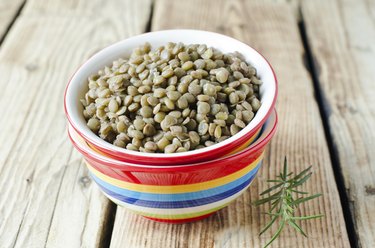
Gout is one of the most painful types of arthritis, according to Johns Hopkins Medicine, and affects an estimated two to five million Americans. It develops when your uric acid levels become excessive and form deposits in a joint, triggering pain, swelling, warmth and redness. In addition to medical treatment, a diet low in purines -- natural substances that trigger uric acid production -- may help manage your symptoms. Lentils may benefit your diet in multiple ways.
Benefits
Video of the Day
Lentils are rich in fiber, which promotes fullness between meals. Improved appetite control may ease the process of weight management, guarding against joint symptoms caused or worsened by excess pounds. Lentils also provide low-fat, cholesterol-free alternatives to fatty protein sources, such as red meat and high-fat cheese. And because lentils contain fewer purines than meat and oily fish, they provide a gout-friendly protein alternative.
Video of the Day
Myths
In the past, gout patients were advised to avoid all foods with significant purine content. Although lower in purines compared to animal products, protein-rich vegetables, including lentils, are considered moderately-high in purines. But while a diet rich in animal protein increases your risk for gout and gout flareups, a vegetable-rich diet does not. In other words, lentils are not linked with same gout risks as meat. The notion that gout is caused by dietary factors is also a myth. Your overall dietary habits may contribute to your symptoms, however, particularly if you have family history of the disease.
Research
In a study published in the "New England Journal of Medicine" in March 2004, researchers analyzed the relationship between the dietary habits and gout occurrences of 47,150 men with no history of gout for 12 years. During the study, 730 new gout cases were recognized. Men who consume diets rich in seafood and meat were the most likely to develop gout, while moderate intake of purine-rich vegetables was not.
Suggestions
To reduce the frequency or intensity of gout symptoms, the March 2006 issue of "Current Opinion in Rheumatology" recommends limiting alcohol, meat and seafood but increasing low-fat dairy products and vitamin C. Have lentil soup instead of chicken noodle, for example, and curried lentils instead of beef atop rice. Because lentils contain more purines than low-protein vegetables, do not choose lentils as your main or only vegetable each day. Viewing lentils as your protein source is a safer option for managing gout. Lower-purine vegetables include string beans, carrots, mushrooms, bell peppers, onions, asparagus, water chestnuts and squash. Additional plant-derived protein sources include beans, tofu, soy milk, soy yogurt and quinoa.
- Johns Hopkins Medicine: Ask Your Doctor About Gout: Diet and Gout
- Current Opinion in Rheumatology: Recent Developments in Diet and Gout
- Acumedico.com: Purine Table
- "New England Journal of Medicine"; Purine-Rich Foods, Dairy and Protein Intake, and the Risk of Gout in Men; Hyon K. Choi et al.; March 2004
Is this an emergency? If you are experiencing serious medical symptoms, please see the National Library of Medicine’s list of signs you need emergency medical attention or call 911.